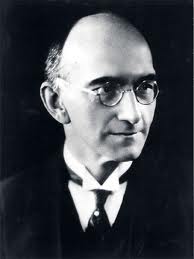Paul Rivet
This article includes a list of generalreferences,butit lacks sufficient correspondinginline citations.(July 2020) |
Paul Rivet | |
|---|---|
 Paul Rivet in 1938 | |
| Born | 7 May 1876 |
| Died | 21 March 1958(aged 81) |
| Nationality | French |
| Known for | Musée de l'Homme Comité de vigilance des intellectuels antifascistes |
| Spouse | Mercedes Andrade Chiriboga |
| Scientific career | |
| Fields | Ethnology |
Paul Rivet(7 May 1876 – 21 March 1958) was aFrenchethnologistknown for founding theMusée de l'Hommein 1937. In his professional work, Rivet is known for his theory thatSouth Americawas originally populated in part by migrants who sailed there fromAustraliaandMelanesia.He married Mercedes Andrade Chiriboga, who was fromCuenca,Ecuador.
Early life and education
[edit]Paul Rivet was born inWasigny,Ardennesin 1876. He attended local schools and university, studying to be a physician.
Career
[edit]Trained as a physician, in 1901 he took part in the SecondFrench Geodesic Missionfor survey measurements of the length of ameridian arctoEcuador.He remained for five years in South America, where he was mentored byFederico González Suárez,an Ecuadorian bishop, historian andarchaeologist.Rivet became interested in theindigenous peoples,beginning an ethnographic study of theHuaorani peopleof the Ecuadorian Amazon, then known as the Jívaro. While in Ecuador he collected specimens of amphibians and reptiles.[1]Returning to France, Rivet went to work with theMuséum national d'histoire naturelle,directed byRené Verneau.
He published several papers on his Ecuadorian research, before publishing an extended volume co-authored with René Verneau, titledAncient Ethnography of Ecuador(1921-1922). In 1926, Rivet participated in founding the Institut d'ethnologie inParis,together withMarcel MaussandLucien Lévy-Bruhl.They intended it as a collaboration among the fields of philosophy, ethnology and sociology. He taught many French ethnologists, includingGeorge Devereux.In 1928, he succeeded René Verneau as director of the National Museum of Natural History.
He continued to develop institutions for the study of mankind. In 1937, he founded theMusée de l'Hommein Paris, which became renowned for its ethnographic research and collections.
In 1942, following Nazi occupation of Paris, Rivet was ousted from his position at the museum. He went to the US whereFranz Boastried to help him along with other academicians displaced by the Nazis. On knowing that the Germans were failing to scientifically prove racial difference and superiority, Boas said, "We should never stop repeating the idea that racism is a monstrous error and an imprudent lie." This exchange took place at a luncheon organised by Boas at the Columbia Faculty Club in honour of Rivet.[2]Beginning his stint inColumbia Universityfrom 1942, Rivet founded the Anthropological Institute and Museum.
Returning to Paris in 1945, he continued teaching while carrying on his research. His linguistic research introduced several new perspectives on theAymaraandQuechua languagesof South America.
Politics
[edit]Rivet also became involved in politics, alarmed at the rise offascismin Europe during the 1930s. During the6 February 1934 crisis,he was one of the founders of theComité de vigilance des intellectuels antifascistes,an antifascist organization created in the wake of massive riots in Paris. Rivet was a leader in the French Resistance to Nazi occupation. He narrowly escaped arrest and execution by the Nazis. Several of his colleagues, includingAnatole LewitskyandBoris Vildewere shot.
Linguistic classification
[edit]Rivet is well known for his classification of South American languages. He proposed 77 language families and about 1240 languages and dialects.[3]Much of his work on language classification was later incorporated byJohn Alden Masonand his former studentČestmír Loukotka.[4]
Migration theory
[edit]Rivet's theory asserts thatAsiawas the origin of theIndigenous people of the Americas.However, he also suggested that migrations to South America were made fromAustraliasome 6,000 years before, and fromMelanesiasomewhat later.Les Origines de l'Homme Américain( "The Origins of the American Man" ) was published in 1943, and containslinguisticand anthropological arguments to support his thesis.
Honors
[edit]Rivet is commemorated in the scientific names of the South American snakeLeptophis riveti[1]and frogPristimantis riveti.[5]
Books
[edit]- withRené Verneau,1921-1922.Ancient Ethnography of Ecuador.
- 1923.L'orfèvrerie du Chiriquí et de Colombie.Paris: Société des Américanistes de Paris.
- 1923.L'orfèvrerie précolombienne des Antilles, des Guyanes, et du Vénézuéla, dans ses rapports avec l'orfèvrerie et la métallurgie des autres régions américaines.Paris: Au siège de la société des Américanistes de Paris.
- 1943.Los origenes del hombre Americano.México: Cuadernos amerícanos.
- 1960.Maya cities: Ancient cities and temples.London: Elek Books.
- with Freund, Gisèle, 1954.Mexique précolombien.Neuchâtel: Éditions Ides et calendes.
References
[edit]- ^abBeolens, Bo; Watkins, Michael; Grayson, Michael (2011).The Eponym Dictionary of Reptiles.Baltimore: Johns Hopkins University Press. xiii + 296 pp.ISBN978-1-4214-0135-5.( "Rivet", p. 222).
- ^King, Charles (2019).Gods of the Upper Air: How a Circle of Renegade Anthropologists Reinvented Race, Sex, and Gender in the Twentieth Century.Doubleday.ISBN9780385542197.
- ^Rivet, Paul. 1924. Langues Américaines III: Langues de l’Amérique du Sud et des Antilles. In: Antoine Meillet and Marcel Cohen (ed.),Les Langues du Monde,Volume 16, 639–712. Paris: Collection Linguistique.
- ^Campbell, Lyle(2012). "Classification of the indigenous languages of South America". In Grondona, Verónica; Campbell, Lyle (eds.).The Indigenous Languages of South America.The World of Linguistics. Vol. 2. Berlin: De Gruyter Mouton. pp. 59–166.ISBN978-3-11-025513-3.
- ^Beolens, Bo; Watkins, Michael & Grayson, Michael (2013).The Eponym Dictionary of Amphibians.Pelagic Publishing. p. 181.ISBN978-1-907807-42-8.
Sources
[edit]- "Paul Rivet",Encyclopædia Britannica
- Alarcón, Arturo G. 2006.Paul Rivet Y La Teoría Oceánica.
- D’Harcourt, Raoul. 1958. "Paul Rivet,"American Anthropologist60(4), 1180-1181
- Rodriguez, Antonio O. 2003.Paul Rivet: Estudioso Del Hombre Americano,Panamericana Editorial.ISBN9583005266
- Spinney, Laura. 2020. "Defying the Nazis" Smithsonian Magazine, June, pages 10, 12-14.
- 1876 births
- 1958 deaths
- People from Ardennes (department)
- Politicians from Grand Est
- French Section of the Workers' International politicians
- Union progressiste politicians
- Members of the Constituent Assembly of France (1945)
- Members of the Constituent Assembly of France (1946)
- Deputies of the 1st National Assembly of the French Fourth Republic
- French ethnologists
- Linguists of Hokan languages
- Historical linguists
- Human Rights League (France) members
- French Resistance members
- Brazilianists
- Linguists of indigenous languages of the Americas
